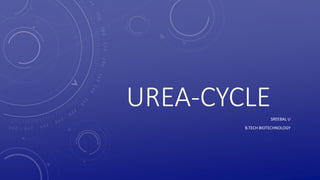
urea cycle.pptx
- 2. REACTION: • The entire process converts two amino groups, one from NH+ 4 and one from aspartate, and a carbon atom from HCO− 3, to the relatively nontoxic excretion product urea.[3] This occurs at the cost of four "high-energy" phosphate bonds (3 ATP hydrolyzed to 2 ADP and one AMP). The conversion from ammonia to urea happens in five main steps. The first is needed for ammonia to enter the cycle and the following four are all a part of the cycle itself. To enter the cycle, ammonia is converted to carbamoyl phosphate. The urea cycle consists of four enzymatic reactions: one mitochondrial and three cytosolic.[1][4] This uses 6 enzymes.[3][4][5]
- 4. STEPS: • Step1-formation of carbamoyl phosphate • Step 2-formation of citruline • Step 3- formation of arginosuccinate • Step4-formation of arginine or cleavage of arginosuccinate • Step 5-formation of urea
- 5. FORMATION OF CARBAMOYL PHOSPHATE CPS-I • MITOCHONDRIA • USE NH3 • UREA CYCLE • ACTIVATED-NAG CPS-II • CYTOSOL • USE GLUTAMINE • PRYIMIDENE BIOSYNTHESIS • INHIBESTED-CTP
- 6. • Carbamoyl phosphate synthase I (CPS I) of mitochondria catalyses the condensation of NH+ ions with CO, to form carbamoyl phosphate. • This step consumes two ATP & is irreversible. • It is a rate-limiting. • CPS I requires N-acetylglutamate for its activity. • Carbamoyl phosphate synthase II (CPS II) - involved in pyrimidine synthesis & it is present in cytosol. • It accepts amino group from glutamine & does not require N-acetylglutamate for its activity.
- 7. FORMATION OF CITRULINE • The second reaction is also mitochondrial. • Citrulline is synthesized from carbamoyl phosphate & ornithine by ornithine transcarbamoylase. • Ornithine is regenerated & used in urea cycle. Ornithine & citrulline are basic amino acids. (Never found in protein structure due to lack of codons). • Citrulline is transported to cytosol by a transporter system. • Citrulline is neither present in tissue proteins nor in blood; but it is present in milk. Ornithine Transcarbomylase • Ornithine + Carbamoyl phosphate Citrulline + Pi
- 8. FORMATION OF ARGINOSUCCINATE • Citrulline condenses with aspartate to form arginosuccinate by the enzyme Arginosuccinate synthetase. • Second amino group of urea is incorporated. • It requires ATP, it is cleaved to AMP & PPi • 2 High energy bonds are required • Immediately broken down to inorganic phosphate (Pi).
- 9. FORMATION OF ARGININE OR CLEAVAGE OF ARGINOSUCCINATE • The enzyme Argininosuccinase or argininosuccinate lyase cleaves arginosuccinate to arginine & fumarate (an intermediate in TCA cycle) • Fumarate provides connecting link with TCA cycle or gluconeogenesis. • The fumarate is converted to oxaloacetate via fumarase & MDH & transaminated to aspartate. • Aspartate is regenerated in this reaction. NAD+ NADH+H • FURMATE MALATE OXALOACETAE ASPARTSTE Fumarase MDH Aminotransferase
- 10. FORMATION OF UREA • Arginase is the 5th and final enzyme that cleaves arginine to yield urea & ornithine. • Ornithine is regenerated, enters mitochondria for its reuse in the urea cycle. • • Arginase is activated by Co²+ & Mn²+ • Ornithine & lysine compete with arginine (competitive inhibition). • Arginase is mostly found in the liver, while the rest of the enzymes (four) of urea cycle are also present in other tissues. • Arginine synthesis may occur to varying degrees in many tissues. • But only the liver can ultimately produce urea.
- 11. ENERGITICS OF UREA CYCLE: • The overall reaction may be summarized as: • • NH3 + CO2 + Aspartate → Urea + fumarate • 2ATPs are used in the 1st reaction. • Another ATP is converted to AMP+ PPI in the 3rd step, which is equivalent to 2 ATPs. • The urea cycle consumes 4 high energy phosphate bonds. • Fumarate formed in the 4th step may be converted to malate. • Malate when oxidised to oxaloacetate produces 1 NADH equivalent to 2.5 ATP. • So net energy expenditure is only 1.5 high energy phosphates. • The urea cycle & TCA cycle are interlinked & it is called as "urea bicycle".
- 12. SIGNIFICANCE OF UREA: • Toxic ammonia is converted into non-toxic urea. • Synthesis of semi-essential amino acid-arginine. • Ornithine is precursor of Proline, Polyamines. • Polyamines include putrescine, spermidine, spermine. • Polyamines have diverse roles in cell growth & proliferation.
- 13. DISPOSAL OF UREA: • Urea produced in the liver freely diffuses & is transported in blood to kidneys & excreted. • A small amount of urea enters the intestine where it is broken down to CO2 & NH3 by the bacterial enzyme urease. • This ammonia is either lost in the feces or absorbed into the blood.
- 15. BLOOD UREA SIGNIFICANCE • Normal blood urea concentration is 10-40 mg/dl. • About 15-30 g of urea (7-15 g nitrogen) is excreted in urine per day. • Blood urea estimation is a screening test for the evaluation of kidney (renal) function. • Elevation in blood urea may be broadly classified into three categories.
- 16. PRE RENAL • This is associated with increased protein breakdown, leading to a negative nitrogen balance. • Observed after major surgery, prolonged fever, diabetic coma, thyrotoxicosis etc. • In leukemia & bleeding disorders also, blood urea is elevated. RENAL In renal disorders like acute glomerulonephritis, chronic nephritis, nephrosclerosis, polycystic kidney, blood urea is increased. Post-renal: Due to obstruction in the urinary tract (e.g. tumors, stones, enlargement of prostate gland etc.) blood urea is elevated. This is due to increased reabsorption of urea from the renal tubules.